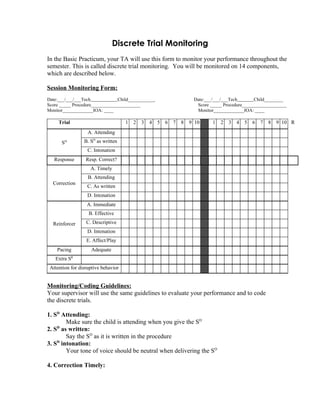
Discrete trial monitoring
- 1. Discrete Trial Monitoring In the Basic Practicum, your TA will use this form to monitor your performance throughout the semester. This is called discrete trial monitoring. You will be monitored on 14 components, which are described below. Session Monitoring Form: Date:___/___/___Tech Child___________ Date:___/___/___Tech Child________ Score _____ Procedure_____________________ Score _____ Procedure___________________ Monitor_____________IOA: ____ Monitor_____________IOA: ____ Trial 1 2 3 4 5 6 7 8 9 10 1 2 3 4 5 6 7 8 9 10 R A. Attending SD B. SD as written C. Intonation Response Resp. Correct? A. Timely B. Attending Correction C. As written D. Intonation A. Immediate B. Effective Reinforcer C. Descriptive D. Intonation E. Affect/Play Pacing Adequate R Extra S Attention for disruptive behavior Monitoring/Coding Guidelines: Your supervisor will use the same guidelines to evaluate your performance and to code the discrete trials. 1. SD Attending: Make sure the child is attending when you give the SD 2. SD as written: Say the SD as it is written in the procedure 3. SD intonation: Your tone of voice should be neutral when delivering the SD 4. Correction Timely:
- 2. As soon as the child has made an incorrect response, provide the correction procedure. Prompted responses are not reinforced, they are followed by a neutral “good”. 5. Correction Attending: The child needs to be attending during correction. 6. Correction as Written: Use the hierarchy of prompts. Do not reinforce or label incorrect behavior. 7. Correction Intonation: For a prompted response, the tone of voice should be neutral. For a correct response, the tone of voice should be excited. R 8. S (Reinforcer) Timely: Give the reinforcer immediately after a correct response (less than 2 seconds). R 9. S Effective: Make sure the child is motivated to work for that reinforcer by conducting frequent preference assessments. 10. SR Intonation: The tone of voice is happy and excited when delivering a reinforcer. 11. Affection and play: Use affection (tickles, making funny faces or sounds) when delivering a reinforcer and play with the reinforcer with your child. 12. Pacing error: Quick pacing between trials, materials are easily accessible. 13. Extra Reinforcement Reinforce the child’s appropriate behavior in the booth and during transitions. If the child engages in problem behavior and then starts behaving appropriately, wait 4 seconds before reinforcing the child for appropriate behavior. 14. Attention for Disruptive Behavior Do not give the child attention for disruptive behavior. Instruct him to return to the appropriate behavior by following the prompt hierarchy.